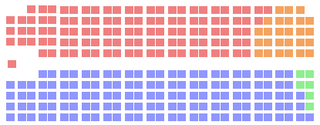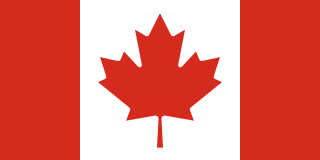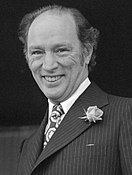
Ernest Charles Manning,, a Canadian politician, was the eighth premier of Alberta between 1943 and 1968 for the Social Credit Party of Alberta. He served longer than any other premier in the province's history and was the second longest serving provincial premier in Canadian history. He was also the only member of the Social Credit Party of Canada to sit in the Senate and, with the party shut out of the House of Commons in 1980, was its very last representative in Parliament.

The 2000 Canadian federal election was held on November 27, 2000, to elect 301 Members of Parliament of the House of Commons of Canada of the 37th Parliament of Canada.
The Canadian social credit movement is a Canadian political movement originally based on the Social Credit theory of Major C. H. Douglas. Its supporters were colloquially known as Socreds in English and créditistes in French. It gained popularity and its own political party in the 1930s, as a result of the Great Depression.

The Canadian federal election of 1972 was held on October 30, 1972, to elect members of the House of Commons of Canada of the 29th Parliament of Canada. It resulted in a slim victory for the governing Liberal Party, which won 109 seats, compared to 107 seats for the opposition Progressive Conservatives. A further 48 seats were won by other parties and independents. On election night, the results appeared to give 109 seats to the Tories, but once the counting had finished the next day, the final results gave the Liberals a minority government and left the New Democratic Party led by David Lewis holding the balance of power. See 29th Canadian parliament for a full list of MPs elected.

The Canadian federal election of 1984 was held on September 4 of that year to elect members of the House of Commons of Canada of the 33rd Parliament of Canada. The Progressive Conservative Party, led by Brian Mulroney, won the largest landslide majority government in Canadian history, while the Liberals suffered what at that time was the worst defeat for a governing party at the federal level. Only the Progressive Conservatives faced a larger defeat, when cut to two seats in 1993.
The Alberta Social Credit Party was a provincial political party in Alberta, Canada, that was founded on social credit monetary policy put forward by Clifford Hugh Douglas and on conservative Christian social values. The Canadian social credit movement was largely an out-growth of the Alberta Social Credit Party. The Social Credit Party of Canada was strongest in Alberta, before developing a base in Quebec when Réal Caouette agreed to merge his Ralliement créditiste movement into the federal party. The British Columbia Social Credit Party formed the government for many years in neighbouring British Columbia, although this was effectively a coalition of centre-right forces in the province that had no interest in social credit monetary policies.

The Canadian federal election of 1968 was held on June 25, 1968, to elect members of the House of Commons of Canada of the 28th Parliament of Canada. The Liberal Party won a majority government under its new leader, Prime Minister Pierre Trudeau.
Historically in Quebec, Canada, there was a number of political parties that were part of the Canadian social credit movement. There were various parties at different times with different names at the provincial level, all broadly following the social credit philosophy; at various times they had varying degrees of affiliation with the Social Credit Party of Canada at the federal level.

The Canadian federal election of 1980 was held on February 18, 1980, to elect members of the House of Commons of Canada of the 32nd Parliament of Canada. It was called when the minority Progressive Conservative government led by Prime Minister Joe Clark was defeated in the Commons.
Robert Norman Thompson was a Canadian politician, chiropractor, and educator. He was born in Duluth, Minnesota, to Canadian parents and moved to Canada in 1918 with his family. Raised in Alberta, he graduated from the Palmer School of Chiropractic in 1939 and worked as a chiropractor and then as a teacher before serving in the Royal Canadian Air Force during World War II.

The Canadian federal election of 1974 was held on July 8, 1974, to elect members of the House of Commons of Canada of the 30th Parliament of Canada. The governing Liberal Party was reelected, going from a minority to a majority government, and gave Prime Minister Pierre Trudeau his third term. The Progressive Conservatives, led by Robert Stanfield, did well in the Atlantic provinces, and in the West, but the Liberal support in Ontario and Quebec ensured a majority Liberal government.

The Canadian federal election of 1958 was the 24th general election in Canada's history. It was held to elect members of the House of Commons of Canada of the 24th Parliament of Canada on March 31, 1958, just nine months after the 23rd election. It transformed Prime Minister John Diefenbaker's minority into the largest majority government in Canadian history and the second largest percentage of the popular vote. Although the Tories would surpass their 1958-seat total in the 1984 election, the 1958 result remains unmatched both in terms of percentage of seats (78.5%) and the size of the Government majority over all opposition parties. Voter turnout was 79.4%.

The Canadian federal election of 1962 was held on June 18, 1962 to elect members of the House of Commons of Canada of the 25th Parliament of Canada. When the election was called, Progressive Conservative (PC) Prime Minister John Diefenbaker had governed for four years with the then-largest majority in the House of Commons in Canadian history.
The Alberta general election of 1982 was the twentieth general election for the Province of Alberta, Canada. It was held on November 2, 1982, to elect members of the Legislative Assembly of Alberta.
In 1963, the Quebec wing of the Social Credit Party of Canada split off from the national party as the Ralliement des créditistes. The split had its roots in a long-standing dispute between the de facto leader of the Ralliement, Réal Caouette, and the party’s national leader, Robert N. Thompson. At the party’s 1960 leadership convention, held two years after the party lost all of its seats in the House of Commons of Canada, Thompson defeated Caouette for the leadership. The party returned to Parliament in the 1962 federal election, but all but four of its 29 MPs came from Quebec. Under the circumstances, Thompson was all but forced to name Caouette as deputy leader of the party. The relationship was strained, however, and the strain was exacerbated when the party failed to make any gains in its old heartland of the Prairies in the 1963 federal election. Only Thompson and three others were elected outside of Quebec, while 20 Socreds were elected in Quebec. The two factions of the party were not re-united until October 1971.
The Canadian social credit movement first contested the 1935 federal election in order to capitalize from the Alberta Social Credit League's surprise victory in Alberta's August 1935 provincial election. Social Credit supporters ran as the Western Social Credit League and John Horne Blackmore was appointed the movement's parliamentary leader following the election although Alberta Premier William Aberhart was generally regarded as the unofficial national leader of the movement.















